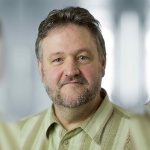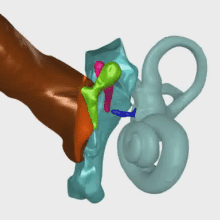Project Description
The hearing organ has the task of converting pressure changes into neural impulses to the brain, thus making it accessible. This is achieved through a complex chain of interlocking functional elements, which achieves a high sensitivity and a wide dynamic range while maintaining high bandwidth of perceived frequencies. Despite its size, the ear has a great resilience to damage. On the chain several transmission media are involved. Airborne noise induces mechanical motion in the middle ear, which are coupled to the fluid of the inner ear.
Under the action of static pressures or high sound intensity is non-linear behavior by linear or non-linear distortion is noticeable. This influence on the one hand the frequency response on the other hand occur in a signal that is not included in the input signal. Through the active amplification mechanism in the inner ear also nonlinear behavior appears already at low irritation. This also leads to the otoacoustic emissions, which can be analyzed in the medical practice.
Damage to the middle ear can be treated surgically to restore the transmission assets, which may include the use of passive or active prostheses. A loss of the amplifier function of the outer hair cells, however, is not reversible, and leads to a considerable decrease of the threshold and a decrease in the frequency selectivity.
The goal of our research is the mathematical description of the frequency-dependent nonlinear transmission behavior of the middle ear with its adjacent structures between the excitation by noise or active middle ear implants. Here, the nonlinear dynamics of the sound conduction chain is accounted for by a three-dimensional mechanical modeling. The parameters of the models can be limited from clinical observations and measurements as well as by theoretical considerations and assessed in their individual scatter. The description of the movement behavior of normal ear and reconstructed ear is performed by three-dimensional models based on the basic laws of dynamics. For modeling multi-body systems, flexible multi-body systems and finite elements are used systems. These can the spatial situation in the ear and the spatial movements of the ossicles and prosthesis simulate realistic.
The simulation of the movement and transfer behavior should allow for optimized tuning of hearing aids, improved interpretation in the diagnosis and development of diagnostic tools. For implants in particular, the nonlinear characteristics of the attachment points, the reduced transmission by bracing of the ossicles and the time relaxation of ligaments of importance. The potential damage from extreme noise exposure and ability in the application of implants should be emulated. Because of the strong networking and coupling of physical processes in hearing this task often requires a very comprehensive look at the data collection and verification of the postulated models and the parameters found.
The individual topic areas
- Modeling of the middle ear
- Modell-Based Hearing Diagnosis
- Acousto-Vibratory Function of the Incudo-Malleal Joint
- Modeling of the inner ear
- Passive and active implants
- Test Rigs and methodic measurement
Contact

Peter Eberhard
Prof. Dr.-Ing. Prof. E.h.- Profile page
- +49 711 685 66388
- Write e-mail
- Pfaffenwaldring 9, 70569 D-Stuttgart
Benjamin Sackmann
M.Sc.(2017 - 2025)


